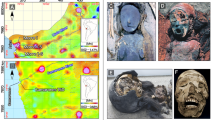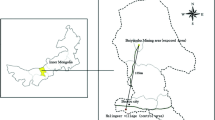Abstract
During the past few centuries, lead production, consumption and emissions, to our total environment have increased remarkably. We have determined the concentrations of lead in 41 well-preserved ancient and 11 contemporary rib bones of a mature age (40–60 y), with a view to historically evaluating lead exposure in humans. The oldest Japanese bones (1000–300b.c.) were found to contain a mean of 0.58 μg Pb/g dry wt and a mean molar ratio of lead to calcium of 0.6×10−6, compared with 4.7–5.2×10−6 in the bones of the Edo era (1600–1867a.d.) and contemporary residents in Japan. The mean molar ratios of female bones were always higher than those of male bones for each era. From this fact we may assume that facial cosmetics were one of the main routes of lead exposure among the ancient Japanese, especially those who lived during the Edo era.
Similar content being viewed by others
References
WHO,Environmental Health Criteria 3, Lead, WHO, Geneva, pp. 30–65, 1977.
K. Tsuchiya, inHandbook on the Toxicology of Metals, vol. 2, L. Friberg, G. F. Nordberg, and V. B. Vouk, eds., Elsevier, Amsterdam, pp. 298–353 (1986).
M. Murozumi, T. J. Chow, and C. Patterson,Geochim. Cosmochim. Acta 33, 1247 (1969).
P. Grandjean, inEnvironmental Quality and Safety, Supplement Vol. II, T. B. Griffin and J. H. Knelson, eds., Georg Thieme, Stuttgart, 1975, pp. 6–75.
P. S. I. Barry,Br. J. Ind. Med. 32, 119 (1975).
Z. Jaworowski, F. Barbalat, C. Blain, and E. Peyre,Sci. Total Environ. 43, 103 (1985).
H. Kosugi, K. Hanihara, T. Suzuki, S. Himeno, T. Kawabe, and T. Hongo,Sci. Total Environ. 52, 93 (1986).
P. Grandjean, O. V. Nielsen, and I. M. Shapiro,J. Environ. Pathol. Toxicol. 2, 781 (1979).
Z. Jawarowski,Nature 217, 152 (1968).
I. M. Shapiro, G. Mitchell, I. Davidson, and S. H. Katz,Arch. Environ. Health 30, 483 (1975).
N. Ishinishi, Y. Eguchi, and A. Hisanaga, inAbstracts of the 19th International Congress on Occupational Health, Dubrovnik, Yugoslavia, 1978, pp. 77.
H. A. Waldron,Ecology of Disease 1, 191 (1982).
J. B. Lambert, S. V. Simpson, J. E. Buikstra, and D. Hanson,Am. J. Phys. Anthropol. 62, 409 (1983).
J. O. Pierce and J. Cholak,Arch. Environ. Health 13, 208 (1966).
Fisher Scientific Co.,Atomic Absorption Analytical Method, no. 9 and no. 37, Waltham, MA, 1970s.
C. C. Patterson,Arch. Environ. Health 11, 344 (1965).
R. O. Becker, J. A. Spadaro, and E. W. Berg,J. Bone Joint Surg. 50, 326 (1968).
G. A. Drasch,Sci. Total Environ. 24, 199 (1982).
J. E. Ericson, H. Shirahata, and C. C. Patterson,New Eng. J. Med. 300, 946 (1979).
J. O. Nriagu,Sci. Total Environ. 31, 105 (1983).
T. Kuge,Mono to Ningen no Bunkashi 4, Kesho (Make-up), Hosei Univ. Pub., Tokyo, 1970, pp 1–353.
K. Kato,Am. J. Dis. Child. 44, 569 (1932).
Author information
Authors and Affiliations
Rights and permissions
About this article
Cite this article
Hisanaga, A., Eguchi, Y., Hirata, M. et al. Lead levels in ancient and contemporary Japanese bones. Biol Trace Elem Res 16, 77–85 (1988). https://doi.org/10.1007/BF02795336
Received:
Accepted:
Issue Date:
DOI: https://doi.org/10.1007/BF02795336




